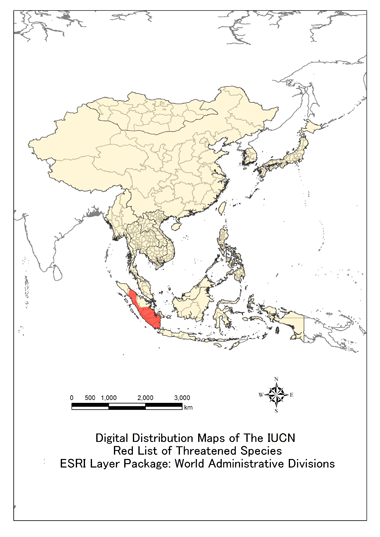
TOP > 生物多様性センターの国際協力 > ESABII > Database > Threatened Mammal Species Database > Presbytis melalophos

Presbytis melalophos
Taxonomy (Name)
| Class | MAMMALIAIUCN | |
|---|---|---|
| Order | DIPROTODONTIAIUCN | |
| Family | CERCOPITHECIDAEIUCN | |
| Scientific Name | Presbytis melalophosIUCN | |
| Author | (Raffles, 1821)IUCN | |
| Synonyms | Presbytis aurata (Muller & Schlegel, 1861) Presbytis batuanus Miller, 1903 Presbytis ferrugineus (Schlegel, 1876) Presbytis flavimanus (I. Geoffroy, 1831) Presbytis fluviatilis (Chasen, 1940) Presbytis fusco-murina Elliot, 1906 Presbytis margae Hooijer, 1948 Presbytis nobilis (Gray, 1842) IUCN |
|
| Common Name | Sumatran Surili, Mitred Leaf Monkey | |
| Local name | Brunei Darussalam | |
| Cambodia | ||
| China | ||
| Indonesia | ||
| Japan | ||
| Lao PDR | ||
| Malaysia | Lotong Ceneka | |
| Myanmar | ||
| Mongolia | ||
| Philippines | ||
| Singapore | ||
| Republic of Korea | ||
| Thailand | ||
| Vietnam | ||
Picture
Distribution, Range
This species is endemic to Sumatra (Indonesia), where it is found south of the Wampu and Simpang Kiri Rivers (except for the eastern coastal forests), and on Pulau Pini in the Batu Archipelago (Groves 2001).
Presbytis melalophos melalophos
Found in southwestern Sumatra, from the upper Sungai Rokan south to the upper Sungai Hari and beyond along the Barisan Range into Lampung (Groves 2001).
Presbytis melalophos mitrata
Found in southeastern Sumatra, from Lampung north to the upper Musi River drainage, west of Palembang, and north to the Batang Hari River (Groves 2001).
Presbytis melalophos bicolor
Found in west-central Sumatra, in the highlands from the middle and lower Sungai Hari to the middle Sungai Inderagiri (Groves 2001).
Presbytis melalophos sumatrana
Found in western Sumatra and Pulau Pini in the Batu Archipelago. On the Sumatran mainland found in the northern highlands and west coast south of the Sungai Simpang Kiri north of Gunung Talamau, southeast to the Rokan River, and on the east coast from Sungai Wampu to the Sungai Barumun.
Map


Country
| Brunei Darussalam | |
|---|---|
| Cambodia | |
| China | |
| Indonesia | |
| Japan | |
| Lao PDR | |
| Malaysia | |
| Myanmar | |
| Mongolia | |
| Philippines | |
| Singapore | |
| Republic of Korea | |
| Thailand | |
| Vietnam |
Status
International Status
IUCN Red List Category
ENIUCN
Justification
The species is considered Endangered due to ongoing population declines driven by habitat conversion and illegal collecting for the pet trade. Although forest loss has probably exceeded 70% over 3 generations (30 years approximately), the subspecies is tolerant to some degree of conversion such that it is likely to persist in fragmented landscapes over the medium term.
CITES
CMS
National Status
| Country | Category | Reference |
|---|---|---|
| Brunei Darussalam | ||
| Cambodia | ||
| China | ||
| Indonesia | ||
| Japan | ||
| Korea | ||
| Lao PDR | ||
| Malaysia | ||
| Mongolia | ||
| Myanmar | ||
| Philippines | ||
| Singapore | ||
| Thailand | ||
| Vietnam |
Ecology Discription
Appearance
Habitat
The species is tolerant of habitat conversion to a degree (V. Nijman pers. comm.), and can be found in disturbed and secondary forest areas. It has also been found in primary and secondary hill rainforest, shrub forest and plantations.
Population size
This species is relatively common (Aimi and Bakar 1992) in its remaining and appropriate habitat, but its occurrence is very patchy and fragmented.
Behavior
Its home range has been observed to be 14-29.5 ha and its daily distance moved is about 300-1,360 m.
Diet
This species is primarily folivorous, but will also consume fruits, flowers, and seeds.
Reproduction
Threat
Major Threat(s)
There has been extensive loss of habitat, especially for oil palm plantations, and this is a serious threat. However, the species has some tolerance to forest conversion. Trapping of the species for the illegal pet trade is a threat across their range, with some incidental hunting for food. Forest fragmentation is a long-term consideration for population persistence (Manullang pers. comm.).
Conservation and Measurement
International
This species is listed under CITES Appendix II.IUCN
National
This species isprotected by national law.IUCN
Conservation law
| Country | Status | Reference |
|---|---|---|
| Brunei Darussalam | ||
| Cambodia | ||
| China | ||
| Indonesia | ||
| Japan | ||
| Korea | ||
| Lao PDR | ||
| Malaysia | ||
| Mongolia | ||
| Myanmar | ||
| Philippines | ||
| Singapore | ||
| Thailand | ||
| Vietnam |
Protected Area
It is known to occur in five protected areas: Berbak National Park, Bukit Barisan National Park, Bukit Sebelah Protection Forest, Kerinci-Seblat National Park, Way Kambas National Park (Indonesia).
Other Coservation Projects
Citation
Aimi, M. and Bakar, A. 1992. Taxonomy and distribution of Presbytis melalophos group in Sumatera, Indonesia. Primates 33(2): 191-206.
Aimi, M. and Bakar, A. 1996. Distribution and deployment of Presbytis melalophos group in Sumatera, Indonesia. Primates 37(4): 399-409.
Groves, C. P. 2001. Primate taxonomy. Smithsonian Institution Press, Washington, DC, USA.
